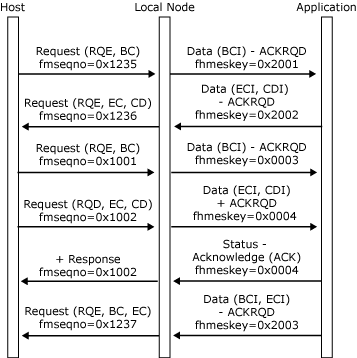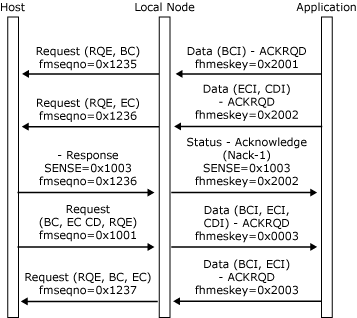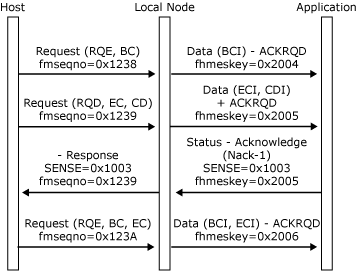Half-Duplex Flip-Flop Direction
The BIND used to establish the session carries information about the initial state of the bracket and direction machines. This can be specified in the BIND if either of the following conditions are satisfied:
Brackets are not used.
Brackets reset state is in-bracket.
If neither of the conditions hold, the initial direction state is contention.
When the direction is specified in the BIND, the application should assume the direction state specified in the half-duplex reset state as soon as data can flow. This field can be obtained indirectly by using a BIND check index that only accepts a particular direction, or directly by reading the HDXRSET field in the bind information control block (BICB) on the Open(PLU) OK Confirm message or by reading the BIND on the Open(PLU) Request. For more information about opening the PLU connection, see Opening the PLU Connection.
When in contention state, either the PLU or the application can initiate a bracket. (For more information, see Brackets.) The successful initiator of the bracket obtains direction unless direction is relinquished when opening the bracket by sending Begin Bracket (BB), Begin Chain (BC), End Chain (EC), or Change Direction (CD). Because the secondary is assumed to be the contention winner, the application can assume send state from contention sending BB and rejecting any subsequent Status-Control(BID) Request from the local node before receiving Status-Session(BETB). When the application accepts a Status-Control(BID) Request in contention state, it must assume receive state.
Half-duplex flip-flop direction can change through the following actions:
Sending or receiving data with the change direction (CD) indicator in the RH, and the corresponding change direction indicator (CDI) flag on the DATAFMI and Status-Control messages. Note that CD is only used at the end of a chain (and for applications receiving segments that will be delivered with ECI, EBIUI). Also note that CD is valid on the following normal flow Status-Control requests: LUSTAT, CANCEL, CHASE and QC.
Receiving a negative response when the application should assume receive state (error recovery pending state). For more information, see Recovery.
If the application rejects data from the host carrying CDI, it must remain in receive state.
Providing the FM profile is correct (3, 4, or 7), the application can request direction from the host using a Status Control(SIGNAL) Request with CODE1 set to 0x0001. CODE2 is set to a user-defined value.
The following three figures illustrate the direction protocol for applications using the half-duplex flip-flop mode.
In the first figure, the application issues and receives the CD without error.

Application issues and receives the CD without errorIn the following figure, the host sends a negative response to inbound data. The application assumes receive state, and then the host sends CD to give the application direction.

Host sends negative response to inbound dataIn the following figure, a complete outbound chain is received without error, but is rejected by the application. Note that even though the chain carried CD, the application does not have direction.

Complete outbound chain received without error, but is rejected by application
See Also
Opening the PLU Connection
PLU Session
Outbound Chaining
Inbound Chaining
Segment Delivery
Brackets
Direction
Pacing and Chunking
Confirmation and Rejection of Data]
Shutdown and Quiesce
Recovery
Application-Initiated Termination
LUSTATs]
Response Time Monitor Data